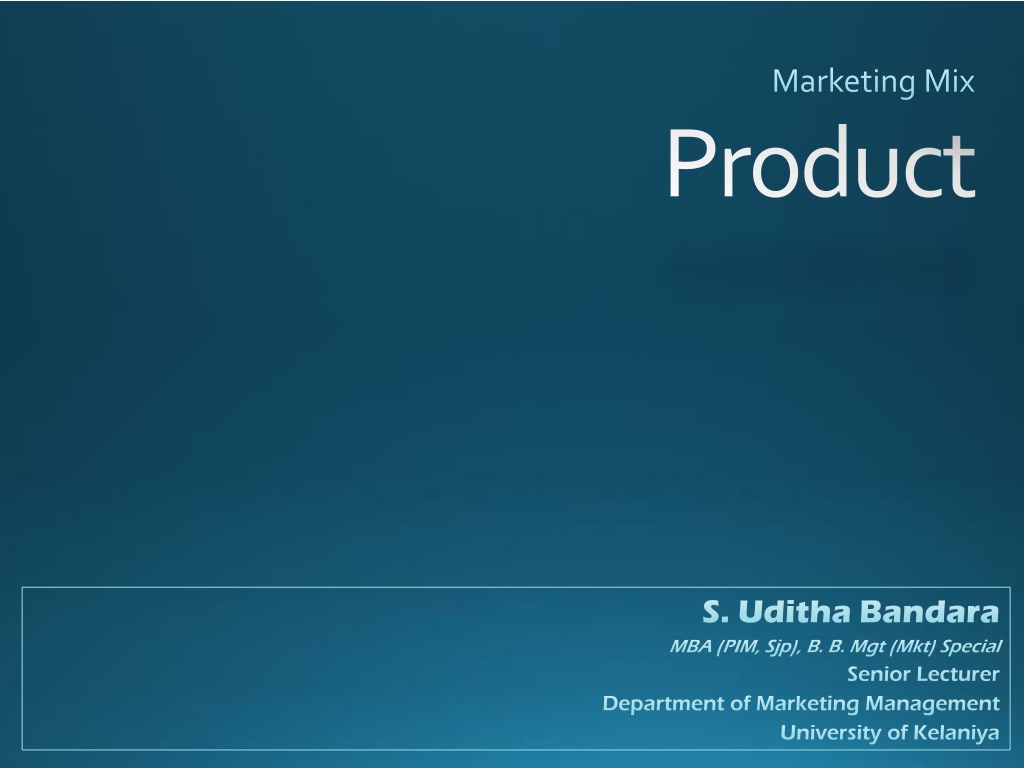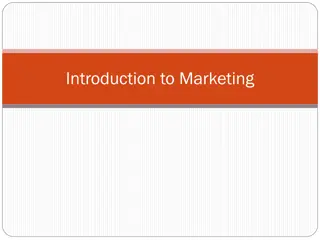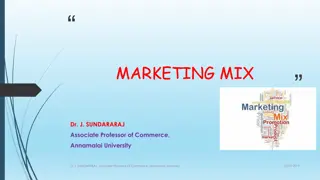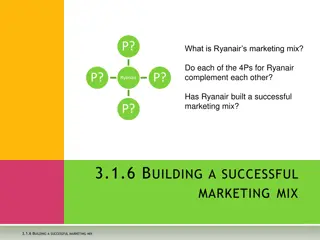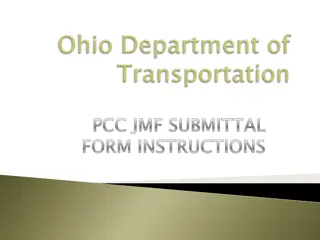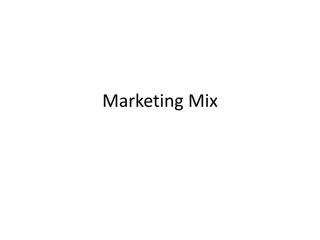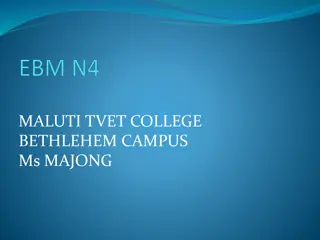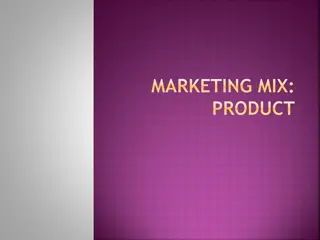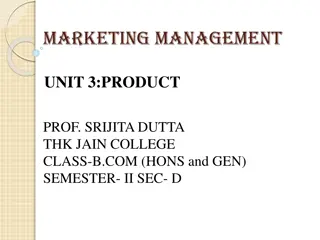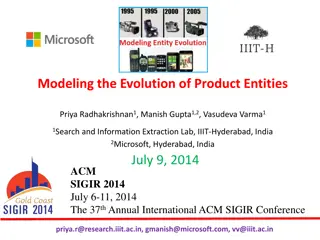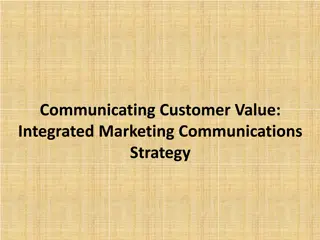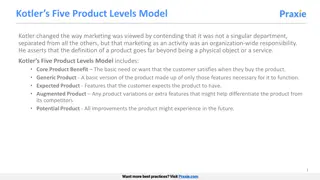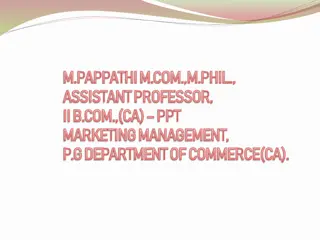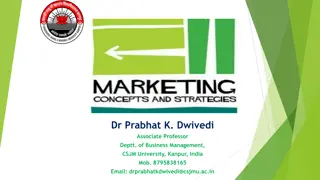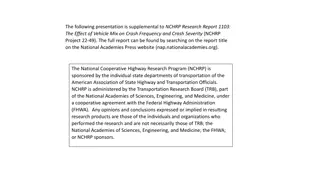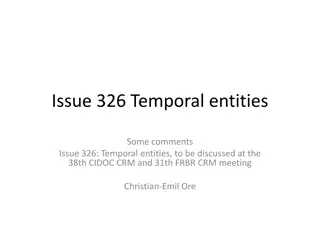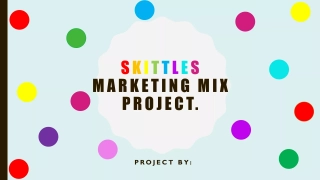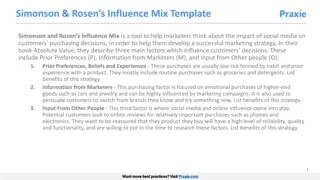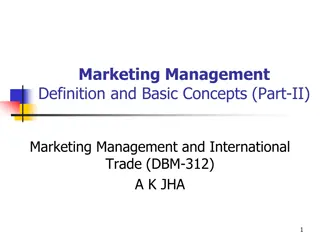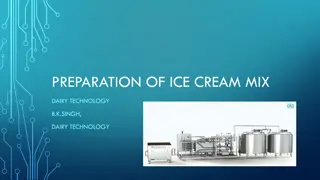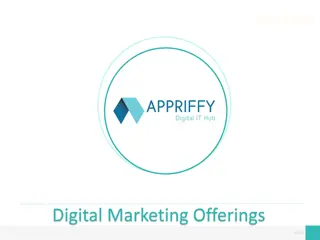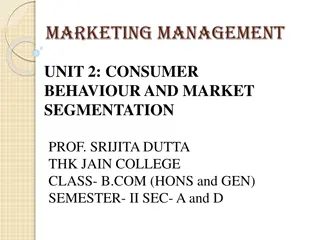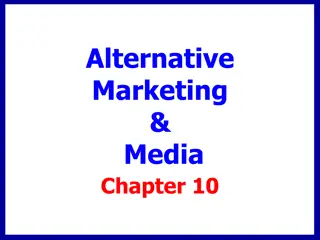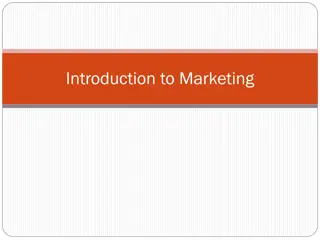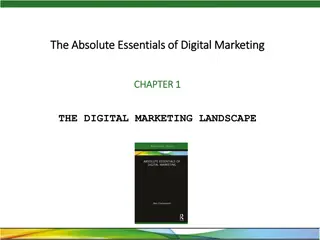Understanding Marketing Mix Entities and Product Offerings
Explore the various components of marketing mix such as product variety, brand, quality, pricing, and distribution channels. Learn how products, services, and experiences are offered to the market and discuss real-world examples of their application in both local and international settings. Delve into the concept of services and intangibility in the marketing realm.
Download Presentation

Please find below an Image/Link to download the presentation.
The content on the website is provided AS IS for your information and personal use only. It may not be sold, licensed, or shared on other websites without obtaining consent from the author. Download presentation by click this link. If you encounter any issues during the download, it is possible that the publisher has removed the file from their server.
E N D
Presentation Transcript
Marketing Mix Product S. Uditha Bandara MBA (PIM, Sjp), B. B. Mgt (Mkt) Special Senior Lecturer Department of Marketing Management University of Kelaniya
Marketing Mix Product Variety Brand Name Quality Design Packaging Warranty Features Services Price List Price Discounts Price discrimination Payment Period Credit Terms Bundling Controllable factors in the marketing environment and managers can change them strategically in order to get higher benefits Target Market Promotion Place Advertising Personal Selling Sales Promotions Public Relations Direct Marketing Promotional Strategy Channels Market Coverage Inventory Locations Transportation Logistics Warehousing
Activity List down the products you know . and Categorize them into different categories according to their features
Product Anything that can be offered to a market for attention, acquisition, use or consumption that might satisfy a want or a need (Kotler). Products includes Physical objects Ideas Ideas Tangible goods ? Services Events Events Places Persons Experiences Experiences Mixes of these entities Organizations
http://library.duke.edu/digitalcollections/media/jpg/oaaaarchives/med/BBB5078.jpghttp://library.duke.edu/digitalcollections/media/jpg/oaaaarchives/med/BBB5078.jpg
https://planetbubble.files.wordpress.com/2012/03/coke-event.jpghttps://planetbubble.files.wordpress.com/2012/03/coke-event.jpg
Group Activity Discuss with your group members about the application of each of the entities mentioned above and identify examples from the market (in Sri Lanka or Internationally)
Services Service is any act or performance that one party can offer another that is essentially intangible and does not result in the ownership of anything. (Kotler, 1991:254)
Service Intangibility - The inability to touch and feel the production of the service. Inseparability Cannotseparate the service provider. Variability Every time a service is performed, it will vary depending onthe service provider orother factors. Perishability Onecannotstoreservices. Pure Tangibles Eg-Toothpaste, Salt, Sugar Tangible goods with an accompanying service Eg- Automobile Pure Services Eg- Baby sitting Consulting Hybrid Equal parts of goods and service Eg- Restaurant A major service with accompanying goods Eg- Air line
The best way to hold customers is to constantly figure out how to give them more for less. More for Less ?
Levels of the product POTENTIAL PRODUCT : Future augmentation & transformation of product AUGMENTED PRODUCT : Exceeds customer expectations EXPECTED PRODUCT : Set of attributes & condition buyer expects BASIC PRODUCT : To turn core benefit into basic product CORE BENEFIT : The fundamental service customer is buying
Group Activity Select 2 products or services of your choice and explain the levels of those products Present your findings to the class and get their ideas
Product classifications Durable / Non durable Tangible / Intangible Consumer / Industrial
Consumer goods Products and services that are purchased by final consumers for their own consumption Specialty Goods Shopping Goods Convenience Goods Unsought Goods Goods that the customer purchases frequently, immediately, and with a minimum comparison and buying effort Convenience Goods Staple Goods - Goods that consumer buy on regular basis Soap, Bread Impulse Goods Purchase with little planning or search effort. Candy bars, Chocolate Emergency Goods Purchase for emergency purposes. Umbrellas during a rainy season.
Shopping Goods Includes mainly durable and semi durable goods where the customers spend time information andcomparing. in gathering Furniture, Computers
Specialty Goods Products which are characterized by an extensive search, consumers are reluctant to accept substitutes for those products. Goods with unique characteristics and brand identification. Branded Cars
Unsought Goods Goods that customers do not actively seek for. These are consumer goods that the consumer either doesn t know about the product or, doesn t normally think of buying. Insurance Policies, Encyclopedias, Novels
Type of Consumer Product Shopping Market Considerations Consumer buying behavior Convenience Specialty Unsought Price Distribution Promotion Examples
Type of Consumer Product Shopping Market Considerations Consumer buying behavior Convenience Specialty Unsought Frequent purchase, little planning, little comparison or shopping effort, low customer involvement Less frequent purchase, must planning and shopping effort, comparison of brands on price, quality, style Strong brand preference and loyalty, special purchase effort, little comparison of brands, low price sensitivity Little product awareness, knowledge (or if aware, little or even negative interest) Price Distribution Low price Widespread distribution, convenient locations Higher price Selective distribution in fewer outlets High price Exclusive distribution in only one or a few outlets per market area More carefully targeted promotion by both producer and resellers Luxury goods, such as Rolex watches or fine crystals Varies Varies Mass promotion by the producer Advertising and personal selling by both producer and reseller Aggressive advertising and personal selling by producer and resellers Life insurance, Red Cross blood donations Promotion Toothpaste, magazines, laundry detergent Televisions, furniture, clothing Examples
Industrial Goods Material & Parts Suppliers & Services Capital items
Branding Strategies Branding Strategies Brands associate with some meanings of characteristics. Attributes Values Personality Benefits Culture User
Individual Product Decisions Product Attributes Branding Packaging Labeling Product Support Services
Product and service attributes Product Quality Product Features Product Style and Design
Branding What is a brand ?
Major Brand Strategy Decisions Brand Decisions Brand No Brand Brand Strategy Decisions Line Extension Brand Extension Multi-brands New Brands Co-Branding Brand Name Individual Names Family Names Company & Individual Names Brand Sponsorship Manufacturer s Brand Private /Distributor Brands Licensed Brands
Branding Strategies Branding Strategies Brand No Brand Manufacturer s Brand Private Brand Individual Brands Family Brands Individual Brands Family Brands Combination Combination
Brand Name Decision Individual brand name- they develop individual brand names foreachseparate product. Blanket family brand name- every products promoted under the samebrand name. Eg. HarischandraProducts Separate Family Brand name Put separate product categories under a family name, under these product categories they makeseveral similar products. Eg. Separate brand name for household appliances, Separate brandnameforelectronic items Company trade names combine with the individual product name E g. - Maliban Cream Cracker, Maliban Chocolate Cream, Maliban double cream
Brand Strategy Decision Line Extension Brand Extension Multi Brand New brand Co-Branding
Packaging Primary Package Secondary package Shipping Package Self service Consumer affluence (consumers are willing to pay additional money for the package for convenience, appearance, durability and prestige) Innovative opportunity - (Innovative packages provide large benefits to the consumer and the marketer also.) Improving company image and brand image Attract attention Protection Knowledge Advertising
Labeling Product supportservices
Product Mix Decisions Width of a product mix Length of product mix Depth of the product mix Consistency of product mix
House and Home Health and Wellness Pet Nutrition and Care Pet Nutrition Personal and Beauty Baby and Family Antiperspirants & Deodorants Old Spice, Secret Colognes Old Spice Cosmetics CoverGirl, Max Factor Feminine Care Health Care Baby & Child Care Pampers Air Fresheners Dish Washing Dawn, Ivory, Joy Household Cleaners Prescription Drugs Laundry & Fabric Care Ivory, Tide Paper Products Hair Care Head & Shoulders Herbal Essences Pantene Hair Color Snacks Pringles Prestige Fragrances BOSS, HUGO, PUMA Shaving Gillette Fusion, Gillette M3 Skin Care Olay
Product Life Product Life Cycle Cycle PLC PLC B.S.S.U. Bandara Lecturer Department of Marketing Management University of Kelaniya
1) Introduction Stage A period of slow sales growth as the product is new to the market. Within this period following characteristics can be identified. Low sales volume Low or no profit Low competition Potential buyers are innovators and early adopters Consumer awareness is low. Promotional expenses are high in this stage
2) Growth Stage A period of rapid market acceptance and substantial profit improvement. In this stage following characteristics can be identified, Potential buyers are early adopters and early majority. Sales volume and profit is growing New competitors are entering to the market. In this stage marketer can use several strategies Improve product quality and add some additional features Enter in to new market segments Add new models Increase distributing coverage and select new distribution channels Shift from product awareness advertisements to product preference advertising Introduce lower prices to obtain the next layer of price sensitive buyers.
3) Maturity Stage A period of slow down in sales growth because of the product has already archived acceptance by most potential buyers. Marketing strategies Market modification Convert non users to users Enter in to new market segments Win competitor s customers Product Modification Increase quality Introduce new features Marketing Mix modification Price Advertising Sales promotion - Personal selling - Service - - Find new channels and modifies existing outlets Use remind ads Provide free items, gift items, reduce price Increase quality of the sales people Increase the service quality -
4) Decline stage The period when sales and profits will slow down. Strategies Increase investments Maintain investments as fix rate until uncertainty is solved Decrease investments Harvesting Diverting
New Product Development-NPD New product development is common practice of modern organizations. There are several steps involve with the process of new product development. Idea Generation Screening Concept Development & Testing Commercialization Marketing Strategy Market Testing Business Analysis Product Development
